Design of a Development Programme for 10 new specialists /subject experts
VerifiedAdded on 2023/04/25
|16
|4048
|243
AI Summary
This document discusses the design of a development programme for 10 new specialists/subject experts for NIKE Sport Camps. It includes internal and external analysis, recruitment, costs, and a five-day training plan.
Contribute Materials
Your contribution can guide someone’s learning journey. Share your
documents today.

BH3392 Student 462780
ASTON UNIVERSITY
Design of a Development Programme for 10 new specialists /subject experts
BH3392 – Learning, Training and Development in
Organisations
Student Number ID: 462780
ASTON UNIVERSITY
Design of a Development Programme for 10 new specialists /subject experts
BH3392 – Learning, Training and Development in
Organisations
Student Number ID: 462780
Secure Best Marks with AI Grader
Need help grading? Try our AI Grader for instant feedback on your assignments.
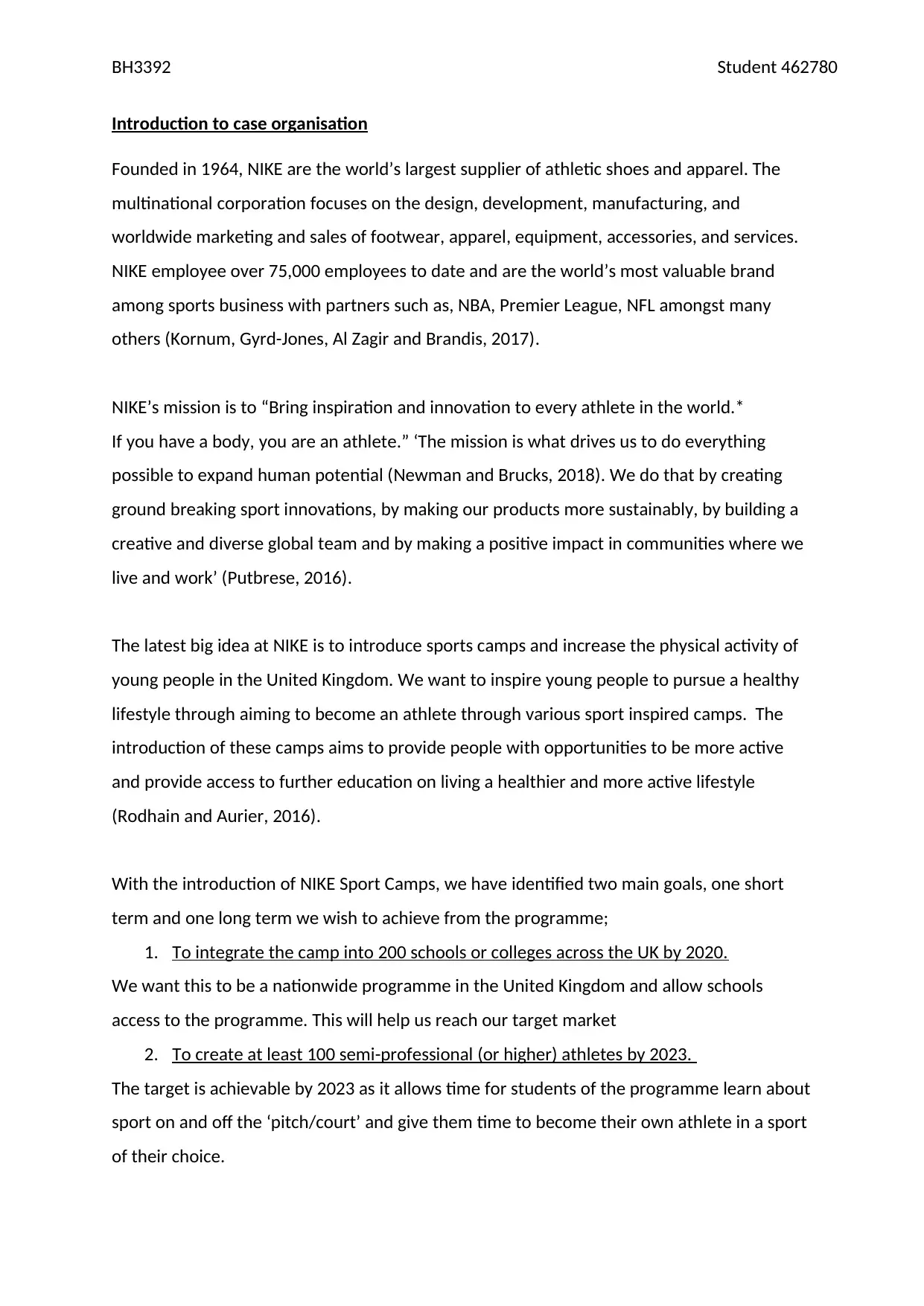
BH3392 Student 462780
Introduction to case organisation
Founded in 1964, NIKE are the world’s largest supplier of athletic shoes and apparel. The
multinational corporation focuses on the design, development, manufacturing, and
worldwide marketing and sales of footwear, apparel, equipment, accessories, and services.
NIKE employee over 75,000 employees to date and are the world’s most valuable brand
among sports business with partners such as, NBA, Premier League, NFL amongst many
others (Kornum, Gyrd-Jones, Al Zagir and Brandis, 2017).
NIKE’s mission is to “Bring inspiration and innovation to every athlete in the world.*
If you have a body, you are an athlete.” ‘The mission is what drives us to do everything
possible to expand human potential (Newman and Brucks, 2018). We do that by creating
ground breaking sport innovations, by making our products more sustainably, by building a
creative and diverse global team and by making a positive impact in communities where we
live and work’ (Putbrese, 2016).
The latest big idea at NIKE is to introduce sports camps and increase the physical activity of
young people in the United Kingdom. We want to inspire young people to pursue a healthy
lifestyle through aiming to become an athlete through various sport inspired camps. The
introduction of these camps aims to provide people with opportunities to be more active
and provide access to further education on living a healthier and more active lifestyle
(Rodhain and Aurier, 2016).
With the introduction of NIKE Sport Camps, we have identified two main goals, one short
term and one long term we wish to achieve from the programme;
1. To integrate the camp into 200 schools or colleges across the UK by 2020.
We want this to be a nationwide programme in the United Kingdom and allow schools
access to the programme. This will help us reach our target market
2. To create at least 100 semi-professional (or higher) athletes by 2023.
The target is achievable by 2023 as it allows time for students of the programme learn about
sport on and off the ‘pitch/court’ and give them time to become their own athlete in a sport
of their choice.
Introduction to case organisation
Founded in 1964, NIKE are the world’s largest supplier of athletic shoes and apparel. The
multinational corporation focuses on the design, development, manufacturing, and
worldwide marketing and sales of footwear, apparel, equipment, accessories, and services.
NIKE employee over 75,000 employees to date and are the world’s most valuable brand
among sports business with partners such as, NBA, Premier League, NFL amongst many
others (Kornum, Gyrd-Jones, Al Zagir and Brandis, 2017).
NIKE’s mission is to “Bring inspiration and innovation to every athlete in the world.*
If you have a body, you are an athlete.” ‘The mission is what drives us to do everything
possible to expand human potential (Newman and Brucks, 2018). We do that by creating
ground breaking sport innovations, by making our products more sustainably, by building a
creative and diverse global team and by making a positive impact in communities where we
live and work’ (Putbrese, 2016).
The latest big idea at NIKE is to introduce sports camps and increase the physical activity of
young people in the United Kingdom. We want to inspire young people to pursue a healthy
lifestyle through aiming to become an athlete through various sport inspired camps. The
introduction of these camps aims to provide people with opportunities to be more active
and provide access to further education on living a healthier and more active lifestyle
(Rodhain and Aurier, 2016).
With the introduction of NIKE Sport Camps, we have identified two main goals, one short
term and one long term we wish to achieve from the programme;
1. To integrate the camp into 200 schools or colleges across the UK by 2020.
We want this to be a nationwide programme in the United Kingdom and allow schools
access to the programme. This will help us reach our target market
2. To create at least 100 semi-professional (or higher) athletes by 2023.
The target is achievable by 2023 as it allows time for students of the programme learn about
sport on and off the ‘pitch/court’ and give them time to become their own athlete in a sport
of their choice.
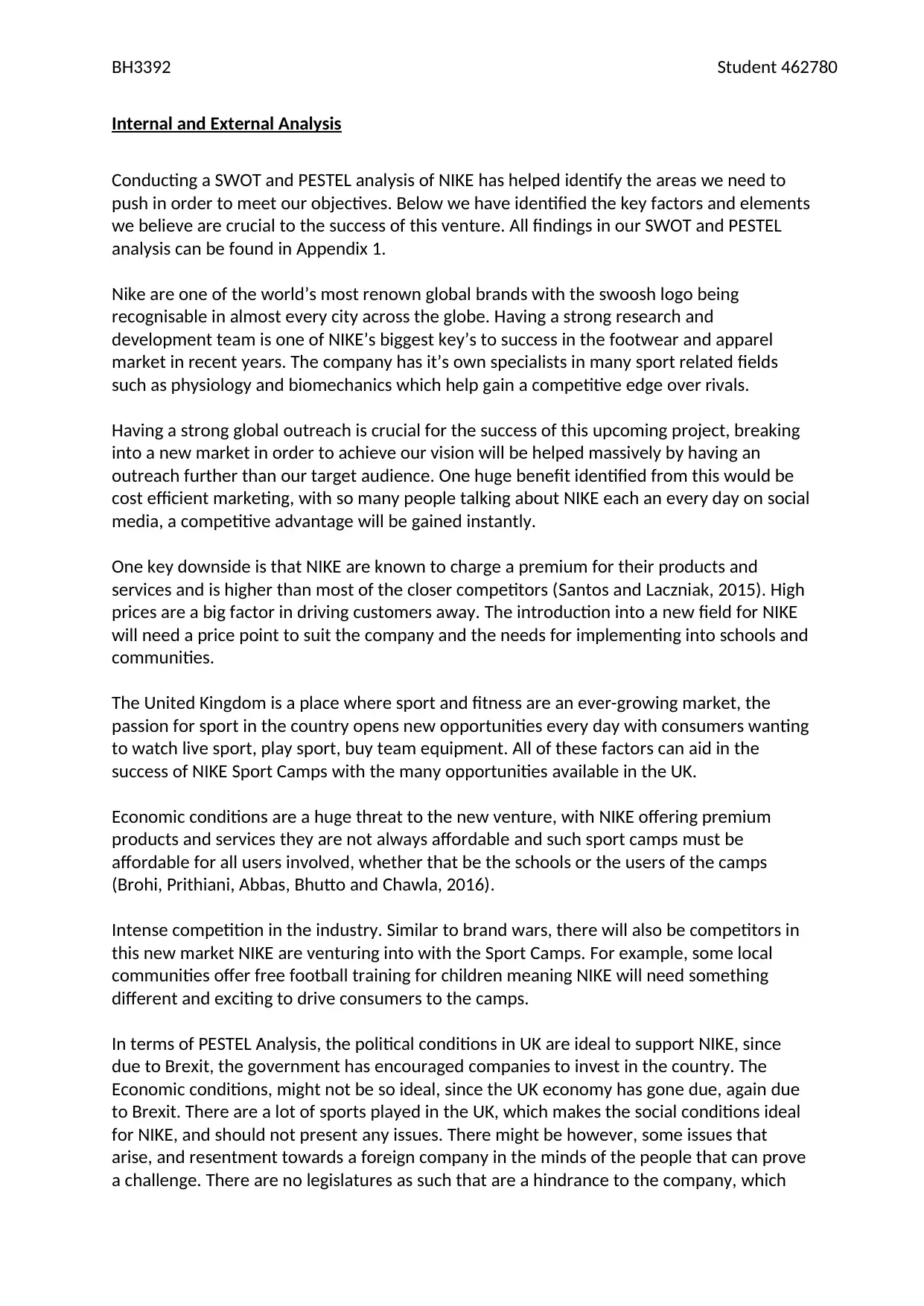
BH3392 Student 462780
Internal and External Analysis
Conducting a SWOT and PESTEL analysis of NIKE has helped identify the areas we need to
push in order to meet our objectives. Below we have identified the key factors and elements
we believe are crucial to the success of this venture. All findings in our SWOT and PESTEL
analysis can be found in Appendix 1.
Nike are one of the world’s most renown global brands with the swoosh logo being
recognisable in almost every city across the globe. Having a strong research and
development team is one of NIKE’s biggest key’s to success in the footwear and apparel
market in recent years. The company has it’s own specialists in many sport related fields
such as physiology and biomechanics which help gain a competitive edge over rivals.
Having a strong global outreach is crucial for the success of this upcoming project, breaking
into a new market in order to achieve our vision will be helped massively by having an
outreach further than our target audience. One huge benefit identified from this would be
cost efficient marketing, with so many people talking about NIKE each an every day on social
media, a competitive advantage will be gained instantly.
One key downside is that NIKE are known to charge a premium for their products and
services and is higher than most of the closer competitors (Santos and Laczniak, 2015). High
prices are a big factor in driving customers away. The introduction into a new field for NIKE
will need a price point to suit the company and the needs for implementing into schools and
communities.
The United Kingdom is a place where sport and fitness are an ever-growing market, the
passion for sport in the country opens new opportunities every day with consumers wanting
to watch live sport, play sport, buy team equipment. All of these factors can aid in the
success of NIKE Sport Camps with the many opportunities available in the UK.
Economic conditions are a huge threat to the new venture, with NIKE offering premium
products and services they are not always affordable and such sport camps must be
affordable for all users involved, whether that be the schools or the users of the camps
(Brohi, Prithiani, Abbas, Bhutto and Chawla, 2016).
Intense competition in the industry. Similar to brand wars, there will also be competitors in
this new market NIKE are venturing into with the Sport Camps. For example, some local
communities offer free football training for children meaning NIKE will need something
different and exciting to drive consumers to the camps.
In terms of PESTEL Analysis, the political conditions in UK are ideal to support NIKE, since
due to Brexit, the government has encouraged companies to invest in the country. The
Economic conditions, might not be so ideal, since the UK economy has gone due, again due
to Brexit. There are a lot of sports played in the UK, which makes the social conditions ideal
for NIKE, and should not present any issues. There might be however, some issues that
arise, and resentment towards a foreign company in the minds of the people that can prove
a challenge. There are no legislatures as such that are a hindrance to the company, which
Internal and External Analysis
Conducting a SWOT and PESTEL analysis of NIKE has helped identify the areas we need to
push in order to meet our objectives. Below we have identified the key factors and elements
we believe are crucial to the success of this venture. All findings in our SWOT and PESTEL
analysis can be found in Appendix 1.
Nike are one of the world’s most renown global brands with the swoosh logo being
recognisable in almost every city across the globe. Having a strong research and
development team is one of NIKE’s biggest key’s to success in the footwear and apparel
market in recent years. The company has it’s own specialists in many sport related fields
such as physiology and biomechanics which help gain a competitive edge over rivals.
Having a strong global outreach is crucial for the success of this upcoming project, breaking
into a new market in order to achieve our vision will be helped massively by having an
outreach further than our target audience. One huge benefit identified from this would be
cost efficient marketing, with so many people talking about NIKE each an every day on social
media, a competitive advantage will be gained instantly.
One key downside is that NIKE are known to charge a premium for their products and
services and is higher than most of the closer competitors (Santos and Laczniak, 2015). High
prices are a big factor in driving customers away. The introduction into a new field for NIKE
will need a price point to suit the company and the needs for implementing into schools and
communities.
The United Kingdom is a place where sport and fitness are an ever-growing market, the
passion for sport in the country opens new opportunities every day with consumers wanting
to watch live sport, play sport, buy team equipment. All of these factors can aid in the
success of NIKE Sport Camps with the many opportunities available in the UK.
Economic conditions are a huge threat to the new venture, with NIKE offering premium
products and services they are not always affordable and such sport camps must be
affordable for all users involved, whether that be the schools or the users of the camps
(Brohi, Prithiani, Abbas, Bhutto and Chawla, 2016).
Intense competition in the industry. Similar to brand wars, there will also be competitors in
this new market NIKE are venturing into with the Sport Camps. For example, some local
communities offer free football training for children meaning NIKE will need something
different and exciting to drive consumers to the camps.
In terms of PESTEL Analysis, the political conditions in UK are ideal to support NIKE, since
due to Brexit, the government has encouraged companies to invest in the country. The
Economic conditions, might not be so ideal, since the UK economy has gone due, again due
to Brexit. There are a lot of sports played in the UK, which makes the social conditions ideal
for NIKE, and should not present any issues. There might be however, some issues that
arise, and resentment towards a foreign company in the minds of the people that can prove
a challenge. There are no legislatures as such that are a hindrance to the company, which
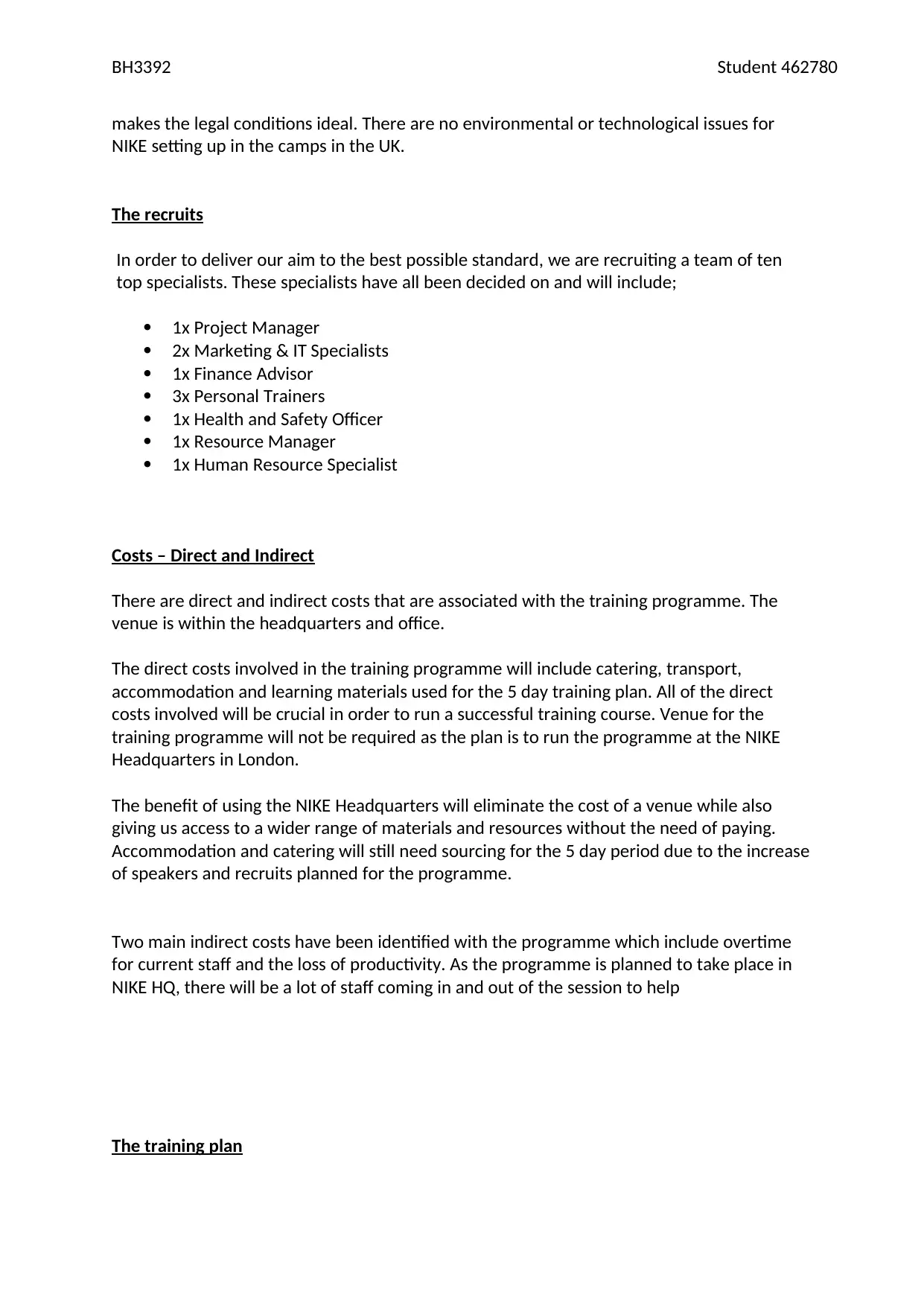
BH3392 Student 462780
makes the legal conditions ideal. There are no environmental or technological issues for
NIKE setting up in the camps in the UK.
The recruits
In order to deliver our aim to the best possible standard, we are recruiting a team of ten
top specialists. These specialists have all been decided on and will include;
1x Project Manager
2x Marketing & IT Specialists
1x Finance Advisor
3x Personal Trainers
1x Health and Safety Officer
1x Resource Manager
1x Human Resource Specialist
Costs – Direct and Indirect
There are direct and indirect costs that are associated with the training programme. The
venue is within the headquarters and office.
The direct costs involved in the training programme will include catering, transport,
accommodation and learning materials used for the 5 day training plan. All of the direct
costs involved will be crucial in order to run a successful training course. Venue for the
training programme will not be required as the plan is to run the programme at the NIKE
Headquarters in London.
The benefit of using the NIKE Headquarters will eliminate the cost of a venue while also
giving us access to a wider range of materials and resources without the need of paying.
Accommodation and catering will still need sourcing for the 5 day period due to the increase
of speakers and recruits planned for the programme.
Two main indirect costs have been identified with the programme which include overtime
for current staff and the loss of productivity. As the programme is planned to take place in
NIKE HQ, there will be a lot of staff coming in and out of the session to help
The training plan
makes the legal conditions ideal. There are no environmental or technological issues for
NIKE setting up in the camps in the UK.
The recruits
In order to deliver our aim to the best possible standard, we are recruiting a team of ten
top specialists. These specialists have all been decided on and will include;
1x Project Manager
2x Marketing & IT Specialists
1x Finance Advisor
3x Personal Trainers
1x Health and Safety Officer
1x Resource Manager
1x Human Resource Specialist
Costs – Direct and Indirect
There are direct and indirect costs that are associated with the training programme. The
venue is within the headquarters and office.
The direct costs involved in the training programme will include catering, transport,
accommodation and learning materials used for the 5 day training plan. All of the direct
costs involved will be crucial in order to run a successful training course. Venue for the
training programme will not be required as the plan is to run the programme at the NIKE
Headquarters in London.
The benefit of using the NIKE Headquarters will eliminate the cost of a venue while also
giving us access to a wider range of materials and resources without the need of paying.
Accommodation and catering will still need sourcing for the 5 day period due to the increase
of speakers and recruits planned for the programme.
Two main indirect costs have been identified with the programme which include overtime
for current staff and the loss of productivity. As the programme is planned to take place in
NIKE HQ, there will be a lot of staff coming in and out of the session to help
The training plan
Secure Best Marks with AI Grader
Need help grading? Try our AI Grader for instant feedback on your assignments.
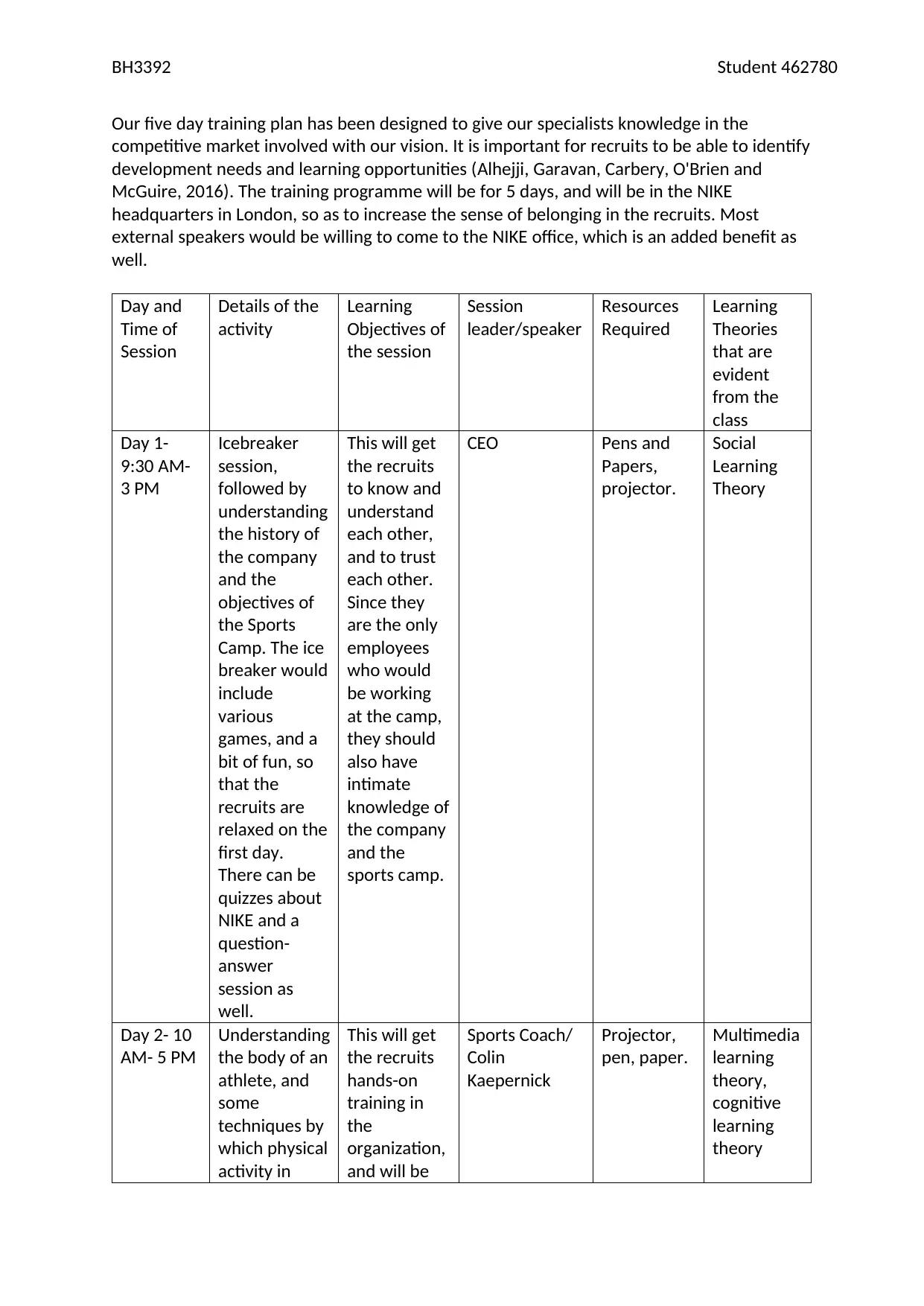
BH3392 Student 462780
Our five day training plan has been designed to give our specialists knowledge in the
competitive market involved with our vision. It is important for recruits to be able to identify
development needs and learning opportunities (Alhejji, Garavan, Carbery, O'Brien and
McGuire, 2016). The training programme will be for 5 days, and will be in the NIKE
headquarters in London, so as to increase the sense of belonging in the recruits. Most
external speakers would be willing to come to the NIKE office, which is an added benefit as
well.
Day and
Time of
Session
Details of the
activity
Learning
Objectives of
the session
Session
leader/speaker
Resources
Required
Learning
Theories
that are
evident
from the
class
Day 1-
9:30 AM-
3 PM
Icebreaker
session,
followed by
understanding
the history of
the company
and the
objectives of
the Sports
Camp. The ice
breaker would
include
various
games, and a
bit of fun, so
that the
recruits are
relaxed on the
first day.
There can be
quizzes about
NIKE and a
question-
answer
session as
well.
This will get
the recruits
to know and
understand
each other,
and to trust
each other.
Since they
are the only
employees
who would
be working
at the camp,
they should
also have
intimate
knowledge of
the company
and the
sports camp.
CEO Pens and
Papers,
projector.
Social
Learning
Theory
Day 2- 10
AM- 5 PM
Understanding
the body of an
athlete, and
some
techniques by
which physical
activity in
This will get
the recruits
hands-on
training in
the
organization,
and will be
Sports Coach/
Colin
Kaepernick
Projector,
pen, paper.
Multimedia
learning
theory,
cognitive
learning
theory
Our five day training plan has been designed to give our specialists knowledge in the
competitive market involved with our vision. It is important for recruits to be able to identify
development needs and learning opportunities (Alhejji, Garavan, Carbery, O'Brien and
McGuire, 2016). The training programme will be for 5 days, and will be in the NIKE
headquarters in London, so as to increase the sense of belonging in the recruits. Most
external speakers would be willing to come to the NIKE office, which is an added benefit as
well.
Day and
Time of
Session
Details of the
activity
Learning
Objectives of
the session
Session
leader/speaker
Resources
Required
Learning
Theories
that are
evident
from the
class
Day 1-
9:30 AM-
3 PM
Icebreaker
session,
followed by
understanding
the history of
the company
and the
objectives of
the Sports
Camp. The ice
breaker would
include
various
games, and a
bit of fun, so
that the
recruits are
relaxed on the
first day.
There can be
quizzes about
NIKE and a
question-
answer
session as
well.
This will get
the recruits
to know and
understand
each other,
and to trust
each other.
Since they
are the only
employees
who would
be working
at the camp,
they should
also have
intimate
knowledge of
the company
and the
sports camp.
CEO Pens and
Papers,
projector.
Social
Learning
Theory
Day 2- 10
AM- 5 PM
Understanding
the body of an
athlete, and
some
techniques by
which physical
activity in
This will get
the recruits
hands-on
training in
the
organization,
and will be
Sports Coach/
Colin
Kaepernick
Projector,
pen, paper.
Multimedia
learning
theory,
cognitive
learning
theory

BH3392 Student 462780
young people
can be
encouraged.
This would
involve
sharing of
experiences
for those of
the recruits
that have
young
children at
home.
able to
encourage
them to
learn the
physical
aspect of
their camps.
In order to
get the
camps off the
ground and
started, they
would have
to know
about
physical
fitness in
young
people, and
motivational
techniques
to get young
people to
take up
physical
fitness.
Day 3- 10-
AM- 5 PM
Teamwork
skills and
people skills,
which includes
leadership
skills. The
recruits will
have to play
games, so that
they are
tested based
on their ability
to understand
people, and
lead teams
( McCormack,
Kilcullen,
Sinatra, Brown
and Beaubien,
2018). They
will be divided
Recruits
should be
able to
understand
their
individual
capacities as
leaders and
as team
members.
Senior
employees and
teams in the
organization.
Projector Social
Learning
Theory,
Behavioural
Learning
Theory
young people
can be
encouraged.
This would
involve
sharing of
experiences
for those of
the recruits
that have
young
children at
home.
able to
encourage
them to
learn the
physical
aspect of
their camps.
In order to
get the
camps off the
ground and
started, they
would have
to know
about
physical
fitness in
young
people, and
motivational
techniques
to get young
people to
take up
physical
fitness.
Day 3- 10-
AM- 5 PM
Teamwork
skills and
people skills,
which includes
leadership
skills. The
recruits will
have to play
games, so that
they are
tested based
on their ability
to understand
people, and
lead teams
( McCormack,
Kilcullen,
Sinatra, Brown
and Beaubien,
2018). They
will be divided
Recruits
should be
able to
understand
their
individual
capacities as
leaders and
as team
members.
Senior
employees and
teams in the
organization.
Projector Social
Learning
Theory,
Behavioural
Learning
Theory
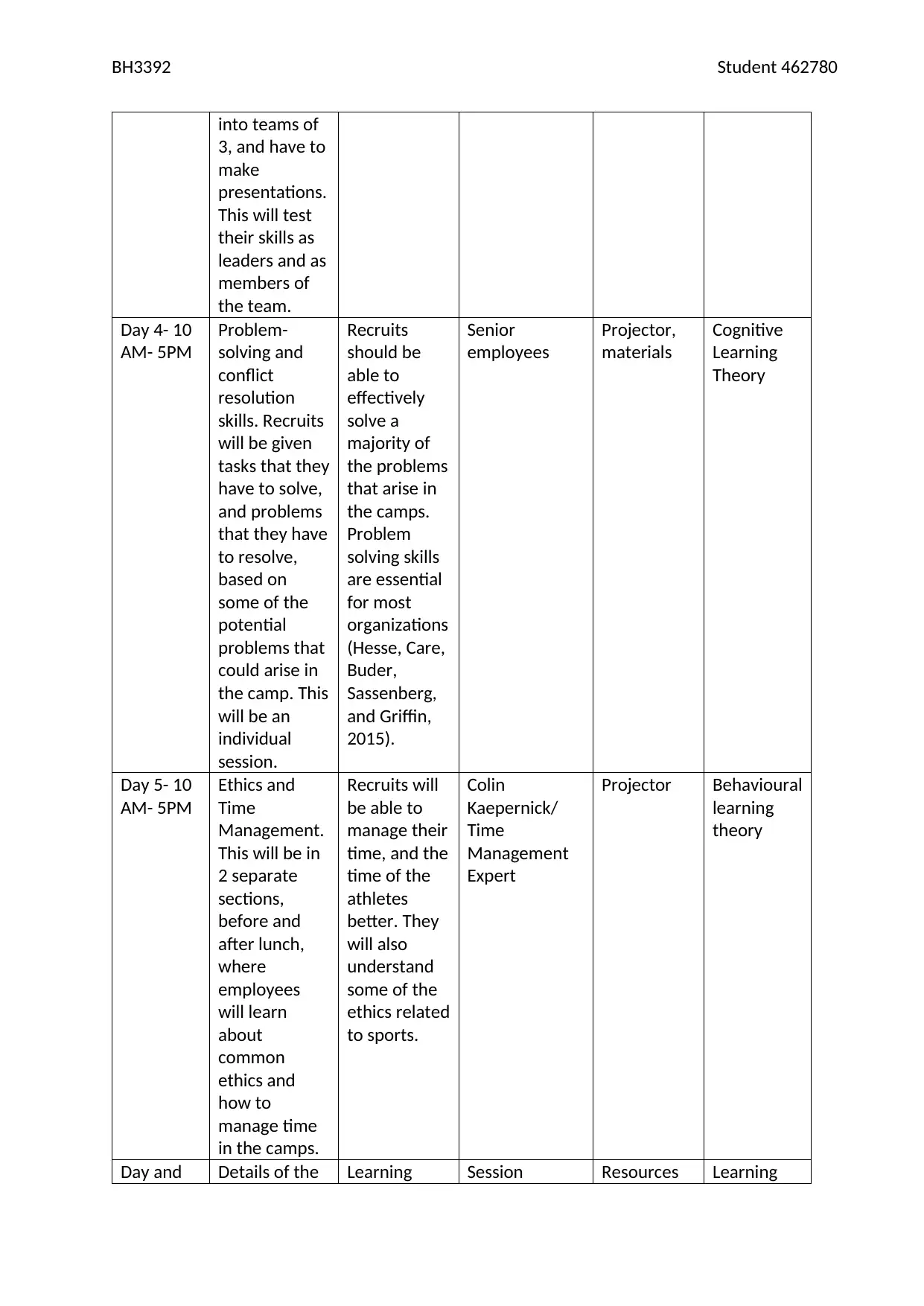
BH3392 Student 462780
into teams of
3, and have to
make
presentations.
This will test
their skills as
leaders and as
members of
the team.
Day 4- 10
AM- 5PM
Problem-
solving and
conflict
resolution
skills. Recruits
will be given
tasks that they
have to solve,
and problems
that they have
to resolve,
based on
some of the
potential
problems that
could arise in
the camp. This
will be an
individual
session.
Recruits
should be
able to
effectively
solve a
majority of
the problems
that arise in
the camps.
Problem
solving skills
are essential
for most
organizations
(Hesse, Care,
Buder,
Sassenberg,
and Griffin,
2015).
Senior
employees
Projector,
materials
Cognitive
Learning
Theory
Day 5- 10
AM- 5PM
Ethics and
Time
Management.
This will be in
2 separate
sections,
before and
after lunch,
where
employees
will learn
about
common
ethics and
how to
manage time
in the camps.
Recruits will
be able to
manage their
time, and the
time of the
athletes
better. They
will also
understand
some of the
ethics related
to sports.
Colin
Kaepernick/
Time
Management
Expert
Projector Behavioural
learning
theory
Day and Details of the Learning Session Resources Learning
into teams of
3, and have to
make
presentations.
This will test
their skills as
leaders and as
members of
the team.
Day 4- 10
AM- 5PM
Problem-
solving and
conflict
resolution
skills. Recruits
will be given
tasks that they
have to solve,
and problems
that they have
to resolve,
based on
some of the
potential
problems that
could arise in
the camp. This
will be an
individual
session.
Recruits
should be
able to
effectively
solve a
majority of
the problems
that arise in
the camps.
Problem
solving skills
are essential
for most
organizations
(Hesse, Care,
Buder,
Sassenberg,
and Griffin,
2015).
Senior
employees
Projector,
materials
Cognitive
Learning
Theory
Day 5- 10
AM- 5PM
Ethics and
Time
Management.
This will be in
2 separate
sections,
before and
after lunch,
where
employees
will learn
about
common
ethics and
how to
manage time
in the camps.
Recruits will
be able to
manage their
time, and the
time of the
athletes
better. They
will also
understand
some of the
ethics related
to sports.
Colin
Kaepernick/
Time
Management
Expert
Projector Behavioural
learning
theory
Day and Details of the Learning Session Resources Learning
Paraphrase This Document
Need a fresh take? Get an instant paraphrase of this document with our AI Paraphraser
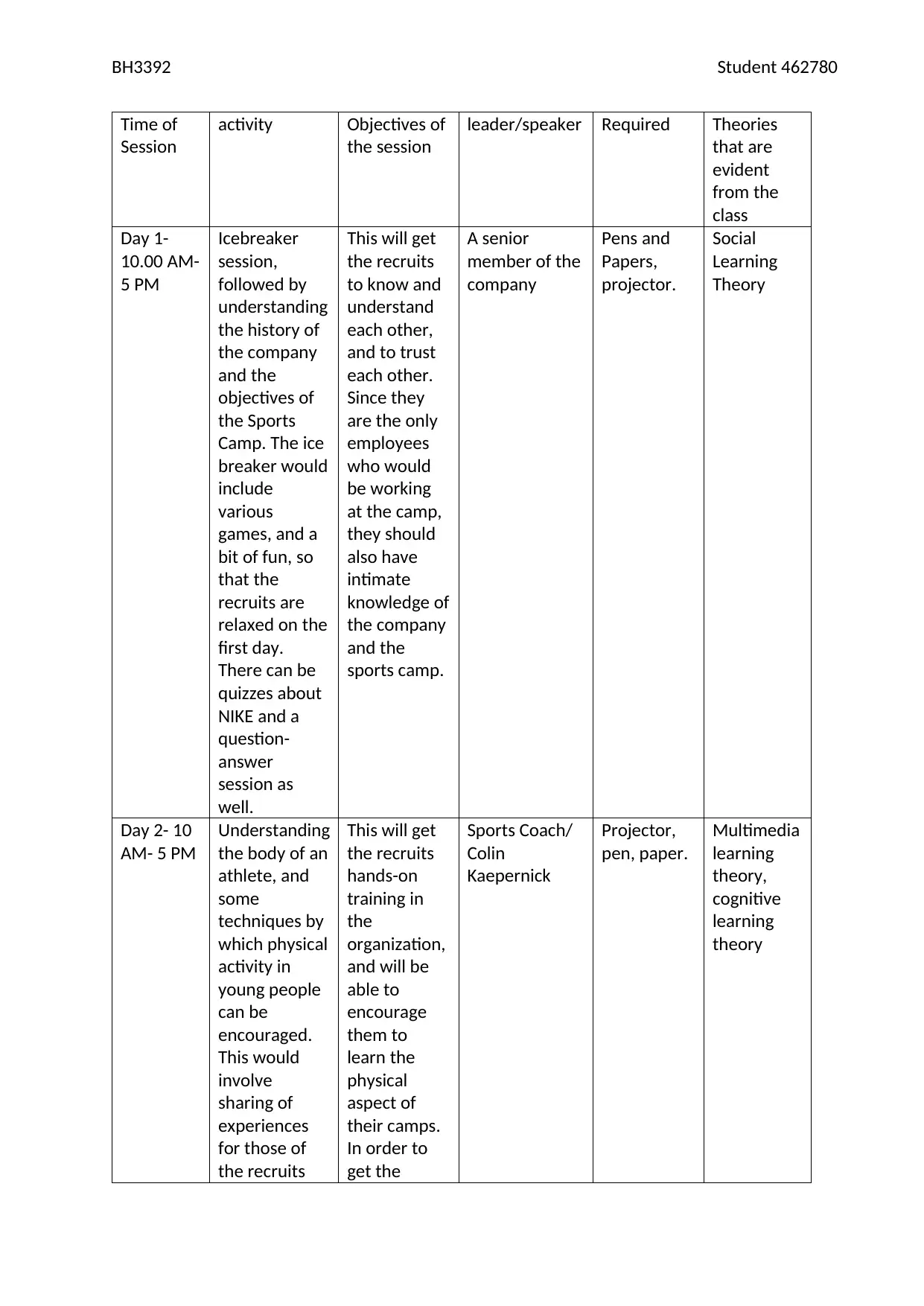
BH3392 Student 462780
Time of
Session
activity Objectives of
the session
leader/speaker Required Theories
that are
evident
from the
class
Day 1-
10.00 AM-
5 PM
Icebreaker
session,
followed by
understanding
the history of
the company
and the
objectives of
the Sports
Camp. The ice
breaker would
include
various
games, and a
bit of fun, so
that the
recruits are
relaxed on the
first day.
There can be
quizzes about
NIKE and a
question-
answer
session as
well.
This will get
the recruits
to know and
understand
each other,
and to trust
each other.
Since they
are the only
employees
who would
be working
at the camp,
they should
also have
intimate
knowledge of
the company
and the
sports camp.
A senior
member of the
company
Pens and
Papers,
projector.
Social
Learning
Theory
Day 2- 10
AM- 5 PM
Understanding
the body of an
athlete, and
some
techniques by
which physical
activity in
young people
can be
encouraged.
This would
involve
sharing of
experiences
for those of
the recruits
This will get
the recruits
hands-on
training in
the
organization,
and will be
able to
encourage
them to
learn the
physical
aspect of
their camps.
In order to
get the
Sports Coach/
Colin
Kaepernick
Projector,
pen, paper.
Multimedia
learning
theory,
cognitive
learning
theory
Time of
Session
activity Objectives of
the session
leader/speaker Required Theories
that are
evident
from the
class
Day 1-
10.00 AM-
5 PM
Icebreaker
session,
followed by
understanding
the history of
the company
and the
objectives of
the Sports
Camp. The ice
breaker would
include
various
games, and a
bit of fun, so
that the
recruits are
relaxed on the
first day.
There can be
quizzes about
NIKE and a
question-
answer
session as
well.
This will get
the recruits
to know and
understand
each other,
and to trust
each other.
Since they
are the only
employees
who would
be working
at the camp,
they should
also have
intimate
knowledge of
the company
and the
sports camp.
A senior
member of the
company
Pens and
Papers,
projector.
Social
Learning
Theory
Day 2- 10
AM- 5 PM
Understanding
the body of an
athlete, and
some
techniques by
which physical
activity in
young people
can be
encouraged.
This would
involve
sharing of
experiences
for those of
the recruits
This will get
the recruits
hands-on
training in
the
organization,
and will be
able to
encourage
them to
learn the
physical
aspect of
their camps.
In order to
get the
Sports Coach/
Colin
Kaepernick
Projector,
pen, paper.
Multimedia
learning
theory,
cognitive
learning
theory
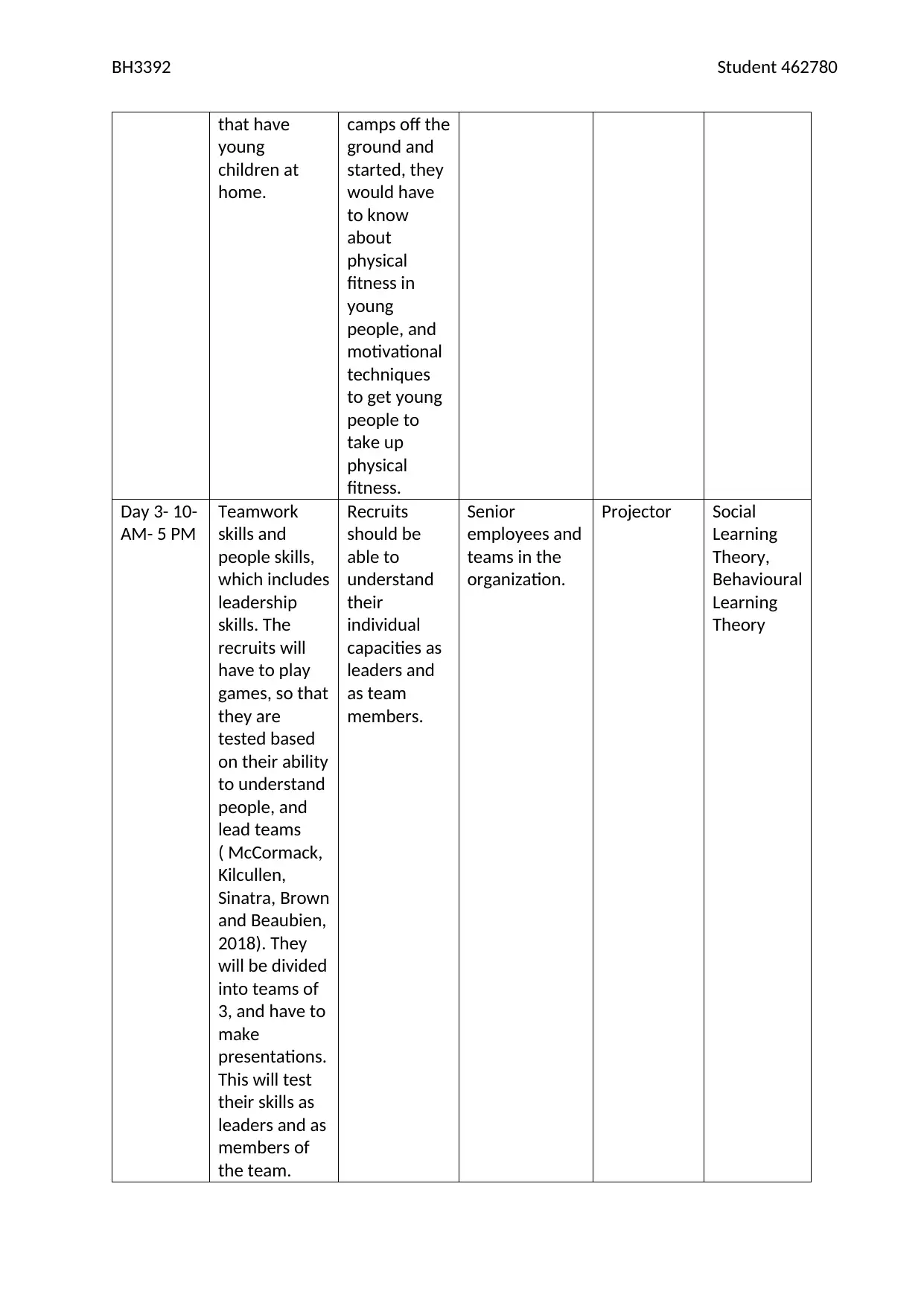
BH3392 Student 462780
that have
young
children at
home.
camps off the
ground and
started, they
would have
to know
about
physical
fitness in
young
people, and
motivational
techniques
to get young
people to
take up
physical
fitness.
Day 3- 10-
AM- 5 PM
Teamwork
skills and
people skills,
which includes
leadership
skills. The
recruits will
have to play
games, so that
they are
tested based
on their ability
to understand
people, and
lead teams
( McCormack,
Kilcullen,
Sinatra, Brown
and Beaubien,
2018). They
will be divided
into teams of
3, and have to
make
presentations.
This will test
their skills as
leaders and as
members of
the team.
Recruits
should be
able to
understand
their
individual
capacities as
leaders and
as team
members.
Senior
employees and
teams in the
organization.
Projector Social
Learning
Theory,
Behavioural
Learning
Theory
that have
young
children at
home.
camps off the
ground and
started, they
would have
to know
about
physical
fitness in
young
people, and
motivational
techniques
to get young
people to
take up
physical
fitness.
Day 3- 10-
AM- 5 PM
Teamwork
skills and
people skills,
which includes
leadership
skills. The
recruits will
have to play
games, so that
they are
tested based
on their ability
to understand
people, and
lead teams
( McCormack,
Kilcullen,
Sinatra, Brown
and Beaubien,
2018). They
will be divided
into teams of
3, and have to
make
presentations.
This will test
their skills as
leaders and as
members of
the team.
Recruits
should be
able to
understand
their
individual
capacities as
leaders and
as team
members.
Senior
employees and
teams in the
organization.
Projector Social
Learning
Theory,
Behavioural
Learning
Theory

BH3392 Student 462780
Day 4- 10
AM- 5PM
Problem-
solving and
conflict
resolution
skills. Recruits
will be given
tasks that they
have to solve,
and problems
that they have
to resolve,
based on
some of the
potential
problems that
could arise in
the camp. This
will be an
individual
session.
Recruits
should be
able to
effectively
solve a
majority of
the problems
that arise in
the camps.
Problem
solving skills
are essential
for most
organizations
(Hesse, Care,
Buder,
Sassenberg,
and Griffin,
2015).
Senior
employees
Projector,
materials
Cognitive
Learning
Theory
Day 5- 10
AM- 5PM
Ethics and
Time
Management.
This will be in
2 separate
sections,
before and
after lunch,
where
employees
will learn
about
common
ethics and
how to
manage time
in the camps.
Recruits will
be able to
manage their
time, and the
time of the
athletes
better. They
will also
understand
some of the
ethics related
to sports.
Colin
Kaepernick/
Time
Management
Expert
Projector Behavioural
learning
theory
Evaluation of plan
Day 4- 10
AM- 5PM
Problem-
solving and
conflict
resolution
skills. Recruits
will be given
tasks that they
have to solve,
and problems
that they have
to resolve,
based on
some of the
potential
problems that
could arise in
the camp. This
will be an
individual
session.
Recruits
should be
able to
effectively
solve a
majority of
the problems
that arise in
the camps.
Problem
solving skills
are essential
for most
organizations
(Hesse, Care,
Buder,
Sassenberg,
and Griffin,
2015).
Senior
employees
Projector,
materials
Cognitive
Learning
Theory
Day 5- 10
AM- 5PM
Ethics and
Time
Management.
This will be in
2 separate
sections,
before and
after lunch,
where
employees
will learn
about
common
ethics and
how to
manage time
in the camps.
Recruits will
be able to
manage their
time, and the
time of the
athletes
better. They
will also
understand
some of the
ethics related
to sports.
Colin
Kaepernick/
Time
Management
Expert
Projector Behavioural
learning
theory
Evaluation of plan
Secure Best Marks with AI Grader
Need help grading? Try our AI Grader for instant feedback on your assignments.
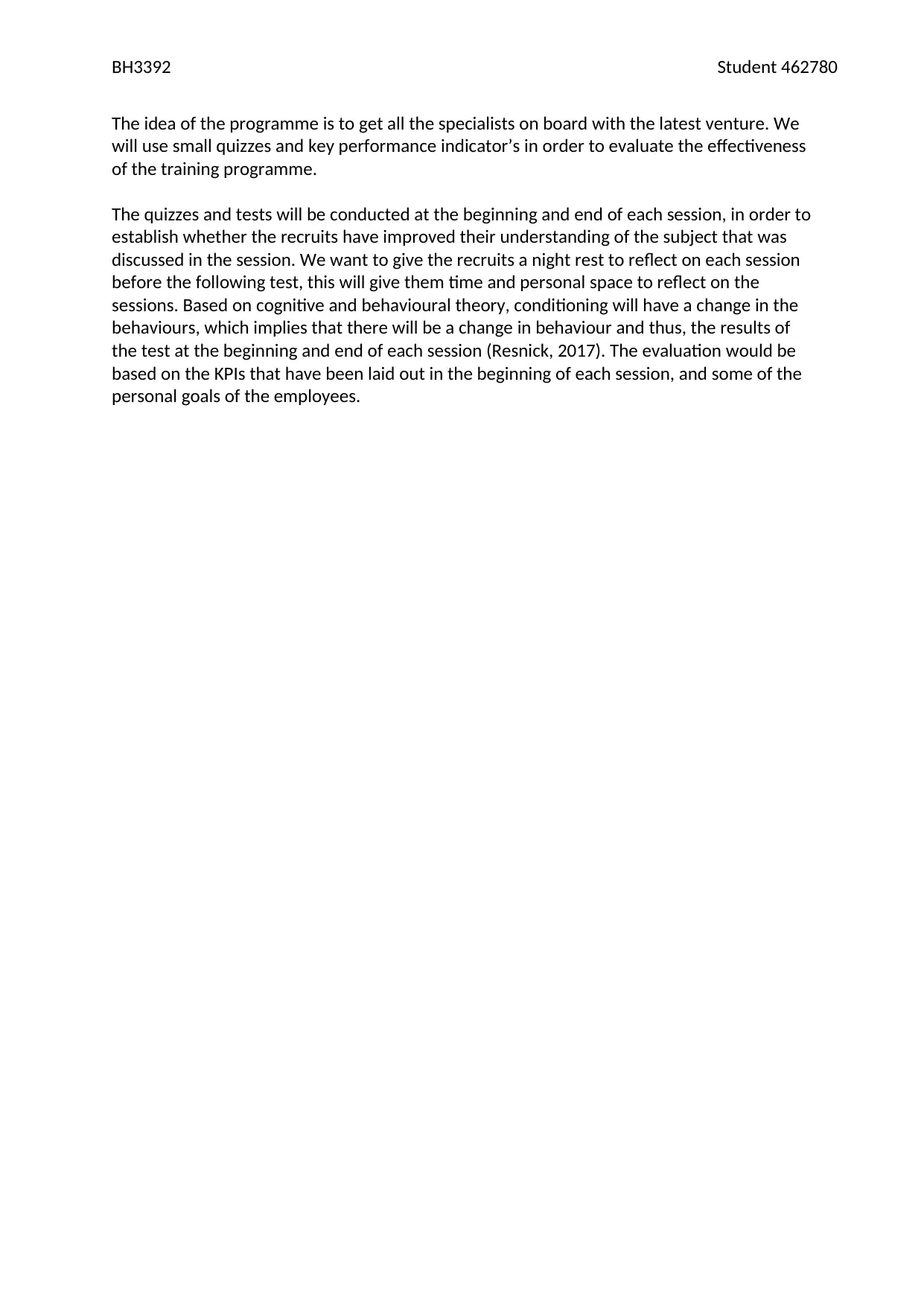
BH3392 Student 462780
The idea of the programme is to get all the specialists on board with the latest venture. We
will use small quizzes and key performance indicator’s in order to evaluate the effectiveness
of the training programme.
The quizzes and tests will be conducted at the beginning and end of each session, in order to
establish whether the recruits have improved their understanding of the subject that was
discussed in the session. We want to give the recruits a night rest to reflect on each session
before the following test, this will give them time and personal space to reflect on the
sessions. Based on cognitive and behavioural theory, conditioning will have a change in the
behaviours, which implies that there will be a change in behaviour and thus, the results of
the test at the beginning and end of each session (Resnick, 2017). The evaluation would be
based on the KPIs that have been laid out in the beginning of each session, and some of the
personal goals of the employees.
The idea of the programme is to get all the specialists on board with the latest venture. We
will use small quizzes and key performance indicator’s in order to evaluate the effectiveness
of the training programme.
The quizzes and tests will be conducted at the beginning and end of each session, in order to
establish whether the recruits have improved their understanding of the subject that was
discussed in the session. We want to give the recruits a night rest to reflect on each session
before the following test, this will give them time and personal space to reflect on the
sessions. Based on cognitive and behavioural theory, conditioning will have a change in the
behaviours, which implies that there will be a change in behaviour and thus, the results of
the test at the beginning and end of each session (Resnick, 2017). The evaluation would be
based on the KPIs that have been laid out in the beginning of each session, and some of the
personal goals of the employees.
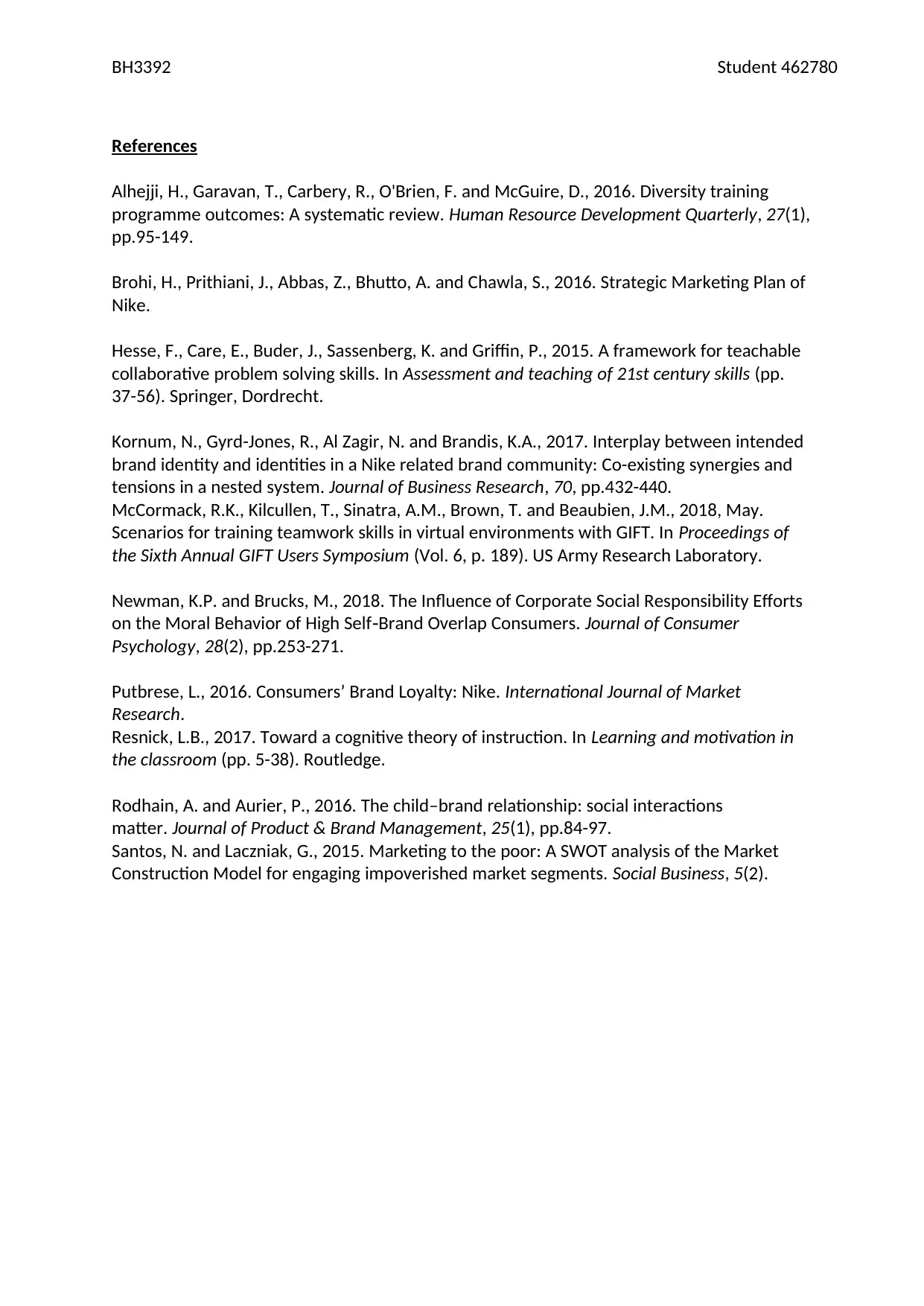
BH3392 Student 462780
References
Alhejji, H., Garavan, T., Carbery, R., O'Brien, F. and McGuire, D., 2016. Diversity training
programme outcomes: A systematic review. Human Resource Development Quarterly, 27(1),
pp.95-149.
Brohi, H., Prithiani, J., Abbas, Z., Bhutto, A. and Chawla, S., 2016. Strategic Marketing Plan of
Nike.
Hesse, F., Care, E., Buder, J., Sassenberg, K. and Griffin, P., 2015. A framework for teachable
collaborative problem solving skills. In Assessment and teaching of 21st century skills (pp.
37-56). Springer, Dordrecht.
Kornum, N., Gyrd-Jones, R., Al Zagir, N. and Brandis, K.A., 2017. Interplay between intended
brand identity and identities in a Nike related brand community: Co-existing synergies and
tensions in a nested system. Journal of Business Research, 70, pp.432-440.
McCormack, R.K., Kilcullen, T., Sinatra, A.M., Brown, T. and Beaubien, J.M., 2018, May.
Scenarios for training teamwork skills in virtual environments with GIFT. In Proceedings of
the Sixth Annual GIFT Users Symposium (Vol. 6, p. 189). US Army Research Laboratory.
Newman, K.P. and Brucks, M., 2018. The Influence of Corporate Social Responsibility Efforts
on the Moral Behavior of High Self Brand Overlap Consumers.‐ Journal of Consumer
Psychology, 28(2), pp.253-271.
Putbrese, L., 2016. Consumers’ Brand Loyalty: Nike. International Journal of Market
Research.
Resnick, L.B., 2017. Toward a cognitive theory of instruction. In Learning and motivation in
the classroom (pp. 5-38). Routledge.
Rodhain, A. and Aurier, P., 2016. The child–brand relationship: social interactions
matter. Journal of Product & Brand Management, 25(1), pp.84-97.
Santos, N. and Laczniak, G., 2015. Marketing to the poor: A SWOT analysis of the Market
Construction Model for engaging impoverished market segments. Social Business, 5(2).
References
Alhejji, H., Garavan, T., Carbery, R., O'Brien, F. and McGuire, D., 2016. Diversity training
programme outcomes: A systematic review. Human Resource Development Quarterly, 27(1),
pp.95-149.
Brohi, H., Prithiani, J., Abbas, Z., Bhutto, A. and Chawla, S., 2016. Strategic Marketing Plan of
Nike.
Hesse, F., Care, E., Buder, J., Sassenberg, K. and Griffin, P., 2015. A framework for teachable
collaborative problem solving skills. In Assessment and teaching of 21st century skills (pp.
37-56). Springer, Dordrecht.
Kornum, N., Gyrd-Jones, R., Al Zagir, N. and Brandis, K.A., 2017. Interplay between intended
brand identity and identities in a Nike related brand community: Co-existing synergies and
tensions in a nested system. Journal of Business Research, 70, pp.432-440.
McCormack, R.K., Kilcullen, T., Sinatra, A.M., Brown, T. and Beaubien, J.M., 2018, May.
Scenarios for training teamwork skills in virtual environments with GIFT. In Proceedings of
the Sixth Annual GIFT Users Symposium (Vol. 6, p. 189). US Army Research Laboratory.
Newman, K.P. and Brucks, M., 2018. The Influence of Corporate Social Responsibility Efforts
on the Moral Behavior of High Self Brand Overlap Consumers.‐ Journal of Consumer
Psychology, 28(2), pp.253-271.
Putbrese, L., 2016. Consumers’ Brand Loyalty: Nike. International Journal of Market
Research.
Resnick, L.B., 2017. Toward a cognitive theory of instruction. In Learning and motivation in
the classroom (pp. 5-38). Routledge.
Rodhain, A. and Aurier, P., 2016. The child–brand relationship: social interactions
matter. Journal of Product & Brand Management, 25(1), pp.84-97.
Santos, N. and Laczniak, G., 2015. Marketing to the poor: A SWOT analysis of the Market
Construction Model for engaging impoverished market segments. Social Business, 5(2).
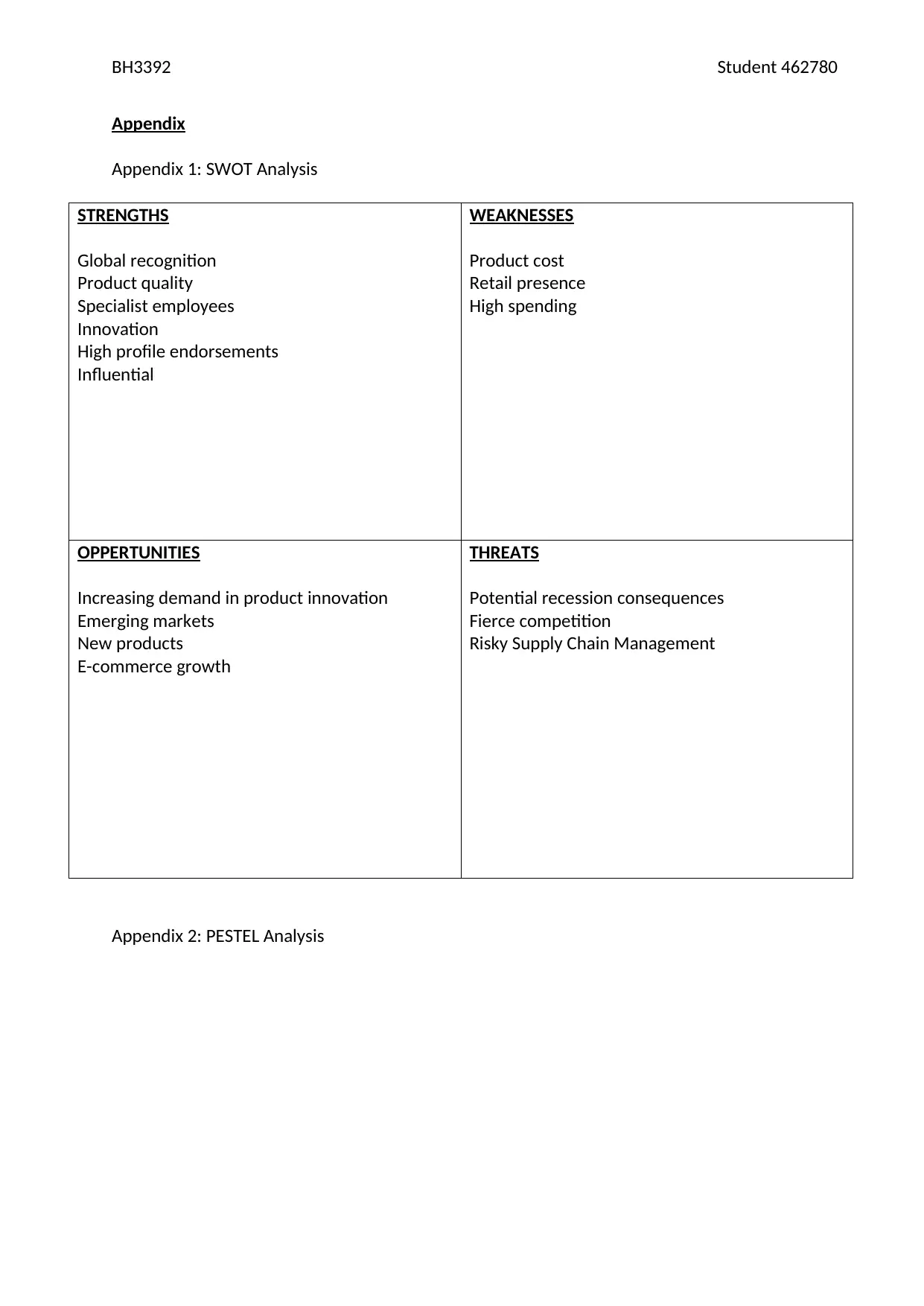
BH3392 Student 462780
Appendix
Appendix 1: SWOT Analysis
STRENGTHS
Global recognition
Product quality
Specialist employees
Innovation
High profile endorsements
Influential
WEAKNESSES
Product cost
Retail presence
High spending
OPPERTUNITIES
Increasing demand in product innovation
Emerging markets
New products
E-commerce growth
THREATS
Potential recession consequences
Fierce competition
Risky Supply Chain Management
Appendix 2: PESTEL Analysis
Appendix
Appendix 1: SWOT Analysis
STRENGTHS
Global recognition
Product quality
Specialist employees
Innovation
High profile endorsements
Influential
WEAKNESSES
Product cost
Retail presence
High spending
OPPERTUNITIES
Increasing demand in product innovation
Emerging markets
New products
E-commerce growth
THREATS
Potential recession consequences
Fierce competition
Risky Supply Chain Management
Appendix 2: PESTEL Analysis
Paraphrase This Document
Need a fresh take? Get an instant paraphrase of this document with our AI Paraphraser
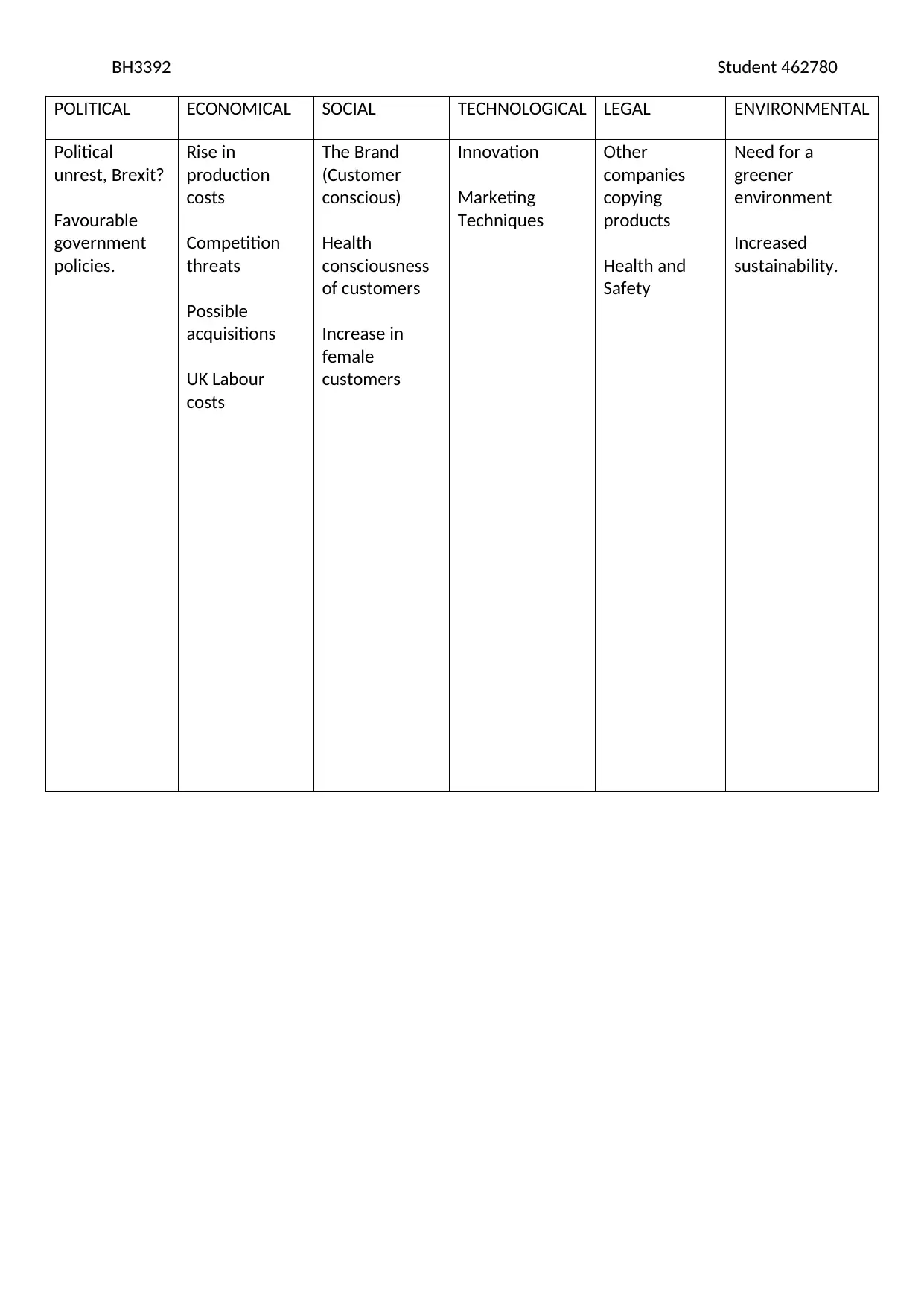
BH3392 Student 462780
POLITICAL ECONOMICAL SOCIAL TECHNOLOGICAL LEGAL ENVIRONMENTAL
Political
unrest, Brexit?
Favourable
government
policies.
Rise in
production
costs
Competition
threats
Possible
acquisitions
UK Labour
costs
The Brand
(Customer
conscious)
Health
consciousness
of customers
Increase in
female
customers
Innovation
Marketing
Techniques
Other
companies
copying
products
Health and
Safety
Need for a
greener
environment
Increased
sustainability.
POLITICAL ECONOMICAL SOCIAL TECHNOLOGICAL LEGAL ENVIRONMENTAL
Political
unrest, Brexit?
Favourable
government
policies.
Rise in
production
costs
Competition
threats
Possible
acquisitions
UK Labour
costs
The Brand
(Customer
conscious)
Health
consciousness
of customers
Increase in
female
customers
Innovation
Marketing
Techniques
Other
companies
copying
products
Health and
Safety
Need for a
greener
environment
Increased
sustainability.
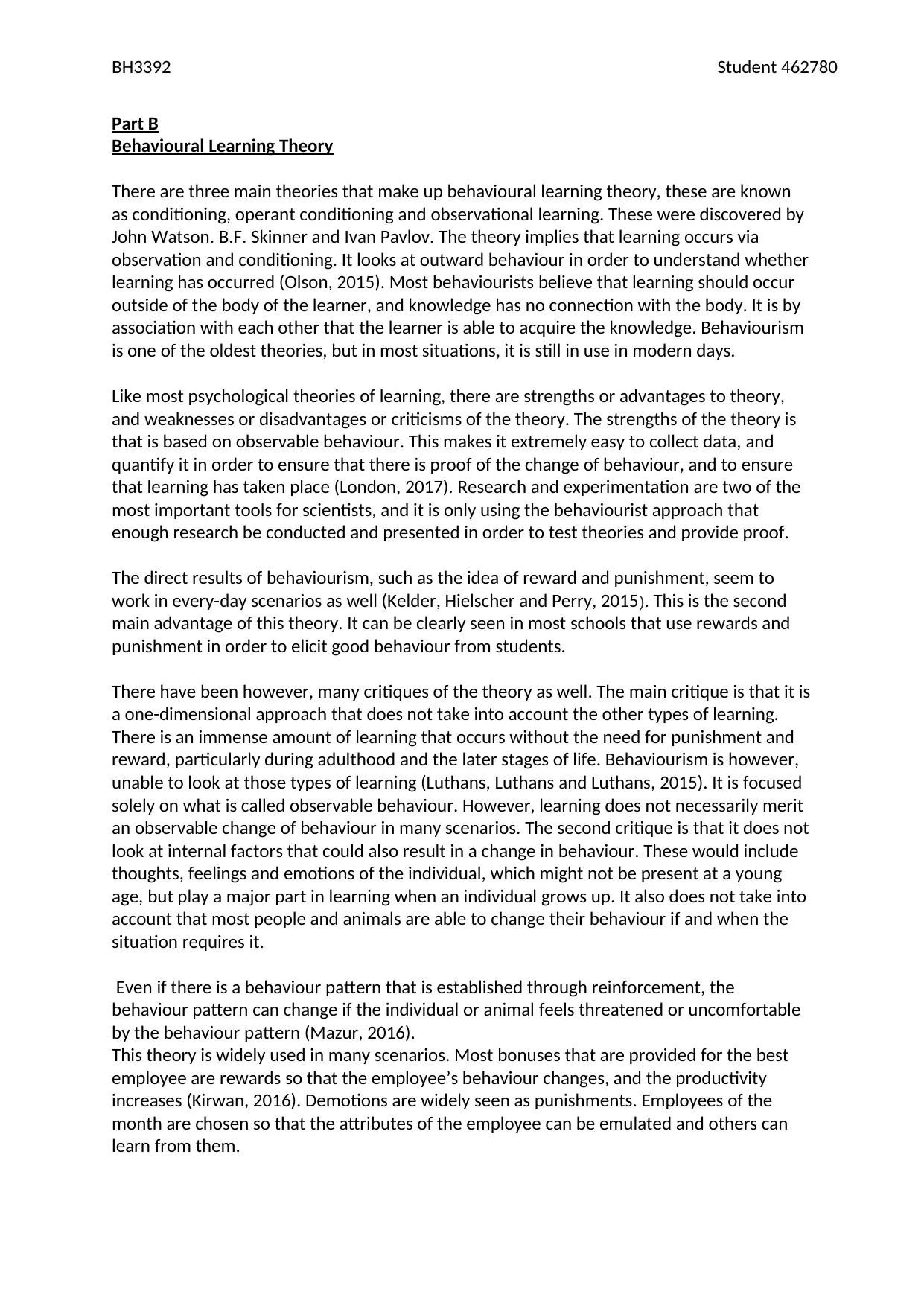
BH3392 Student 462780
Part B
Behavioural Learning Theory
There are three main theories that make up behavioural learning theory, these are known
as conditioning, operant conditioning and observational learning. These were discovered by
John Watson. B.F. Skinner and Ivan Pavlov. The theory implies that learning occurs via
observation and conditioning. It looks at outward behaviour in order to understand whether
learning has occurred (Olson, 2015). Most behaviourists believe that learning should occur
outside of the body of the learner, and knowledge has no connection with the body. It is by
association with each other that the learner is able to acquire the knowledge. Behaviourism
is one of the oldest theories, but in most situations, it is still in use in modern days.
Like most psychological theories of learning, there are strengths or advantages to theory,
and weaknesses or disadvantages or criticisms of the theory. The strengths of the theory is
that is based on observable behaviour. This makes it extremely easy to collect data, and
quantify it in order to ensure that there is proof of the change of behaviour, and to ensure
that learning has taken place (London, 2017). Research and experimentation are two of the
most important tools for scientists, and it is only using the behaviourist approach that
enough research be conducted and presented in order to test theories and provide proof.
The direct results of behaviourism, such as the idea of reward and punishment, seem to
work in every-day scenarios as well (Kelder, Hielscher and Perry, 2015). This is the second
main advantage of this theory. It can be clearly seen in most schools that use rewards and
punishment in order to elicit good behaviour from students.
There have been however, many critiques of the theory as well. The main critique is that it is
a one-dimensional approach that does not take into account the other types of learning.
There is an immense amount of learning that occurs without the need for punishment and
reward, particularly during adulthood and the later stages of life. Behaviourism is however,
unable to look at those types of learning (Luthans, Luthans and Luthans, 2015). It is focused
solely on what is called observable behaviour. However, learning does not necessarily merit
an observable change of behaviour in many scenarios. The second critique is that it does not
look at internal factors that could also result in a change in behaviour. These would include
thoughts, feelings and emotions of the individual, which might not be present at a young
age, but play a major part in learning when an individual grows up. It also does not take into
account that most people and animals are able to change their behaviour if and when the
situation requires it.
Even if there is a behaviour pattern that is established through reinforcement, the
behaviour pattern can change if the individual or animal feels threatened or uncomfortable
by the behaviour pattern (Mazur, 2016).
This theory is widely used in many scenarios. Most bonuses that are provided for the best
employee are rewards so that the employee’s behaviour changes, and the productivity
increases (Kirwan, 2016). Demotions are widely seen as punishments. Employees of the
month are chosen so that the attributes of the employee can be emulated and others can
learn from them.
Part B
Behavioural Learning Theory
There are three main theories that make up behavioural learning theory, these are known
as conditioning, operant conditioning and observational learning. These were discovered by
John Watson. B.F. Skinner and Ivan Pavlov. The theory implies that learning occurs via
observation and conditioning. It looks at outward behaviour in order to understand whether
learning has occurred (Olson, 2015). Most behaviourists believe that learning should occur
outside of the body of the learner, and knowledge has no connection with the body. It is by
association with each other that the learner is able to acquire the knowledge. Behaviourism
is one of the oldest theories, but in most situations, it is still in use in modern days.
Like most psychological theories of learning, there are strengths or advantages to theory,
and weaknesses or disadvantages or criticisms of the theory. The strengths of the theory is
that is based on observable behaviour. This makes it extremely easy to collect data, and
quantify it in order to ensure that there is proof of the change of behaviour, and to ensure
that learning has taken place (London, 2017). Research and experimentation are two of the
most important tools for scientists, and it is only using the behaviourist approach that
enough research be conducted and presented in order to test theories and provide proof.
The direct results of behaviourism, such as the idea of reward and punishment, seem to
work in every-day scenarios as well (Kelder, Hielscher and Perry, 2015). This is the second
main advantage of this theory. It can be clearly seen in most schools that use rewards and
punishment in order to elicit good behaviour from students.
There have been however, many critiques of the theory as well. The main critique is that it is
a one-dimensional approach that does not take into account the other types of learning.
There is an immense amount of learning that occurs without the need for punishment and
reward, particularly during adulthood and the later stages of life. Behaviourism is however,
unable to look at those types of learning (Luthans, Luthans and Luthans, 2015). It is focused
solely on what is called observable behaviour. However, learning does not necessarily merit
an observable change of behaviour in many scenarios. The second critique is that it does not
look at internal factors that could also result in a change in behaviour. These would include
thoughts, feelings and emotions of the individual, which might not be present at a young
age, but play a major part in learning when an individual grows up. It also does not take into
account that most people and animals are able to change their behaviour if and when the
situation requires it.
Even if there is a behaviour pattern that is established through reinforcement, the
behaviour pattern can change if the individual or animal feels threatened or uncomfortable
by the behaviour pattern (Mazur, 2016).
This theory is widely used in many scenarios. Most bonuses that are provided for the best
employee are rewards so that the employee’s behaviour changes, and the productivity
increases (Kirwan, 2016). Demotions are widely seen as punishments. Employees of the
month are chosen so that the attributes of the employee can be emulated and others can
learn from them.
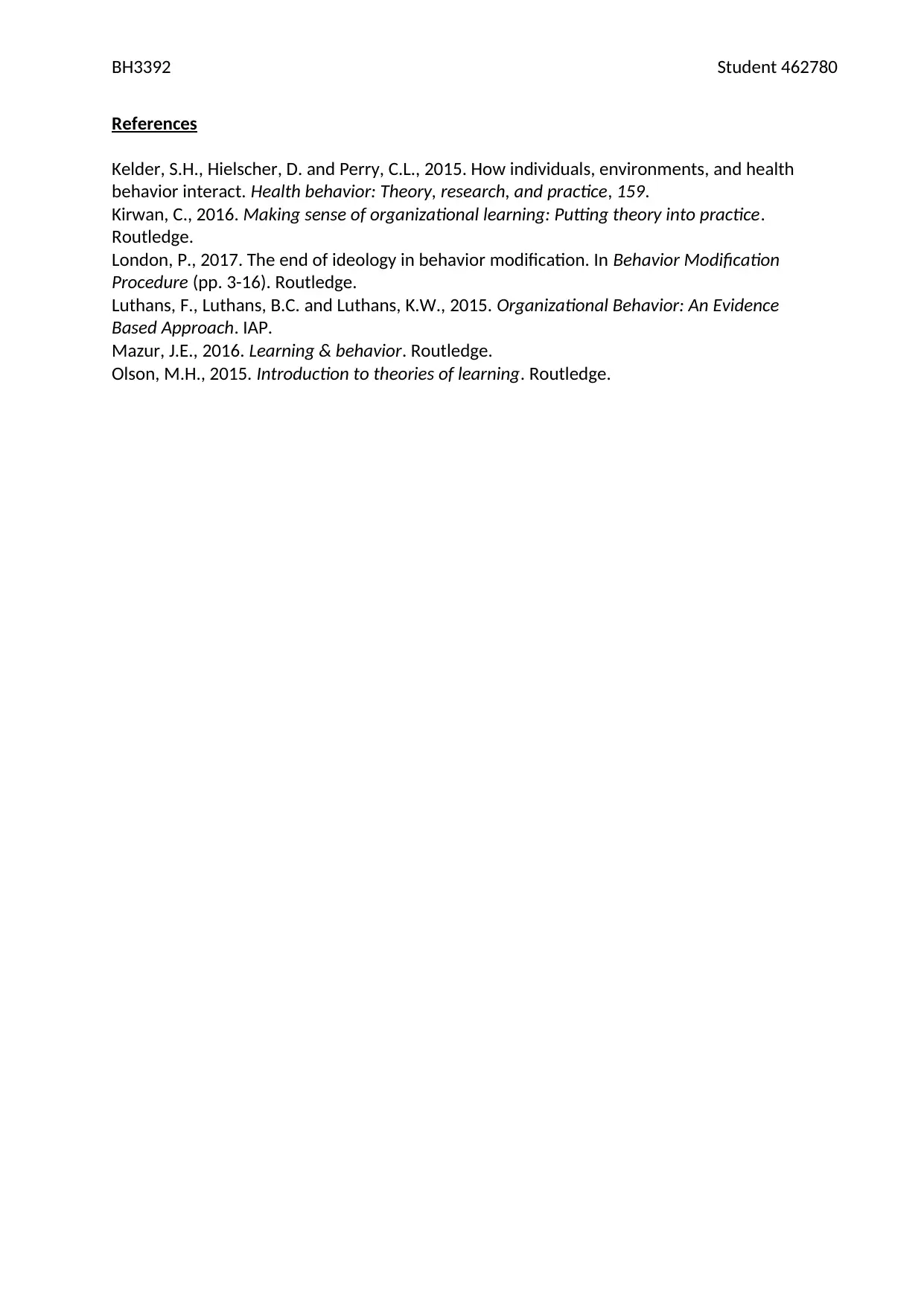
BH3392 Student 462780
References
Kelder, S.H., Hielscher, D. and Perry, C.L., 2015. How individuals, environments, and health
behavior interact. Health behavior: Theory, research, and practice, 159.
Kirwan, C., 2016. Making sense of organizational learning: Putting theory into practice.
Routledge.
London, P., 2017. The end of ideology in behavior modification. In Behavior Modification
Procedure (pp. 3-16). Routledge.
Luthans, F., Luthans, B.C. and Luthans, K.W., 2015. Organizational Behavior: An Evidence
Based Approach. IAP.
Mazur, J.E., 2016. Learning & behavior. Routledge.
Olson, M.H., 2015. Introduction to theories of learning. Routledge.
References
Kelder, S.H., Hielscher, D. and Perry, C.L., 2015. How individuals, environments, and health
behavior interact. Health behavior: Theory, research, and practice, 159.
Kirwan, C., 2016. Making sense of organizational learning: Putting theory into practice.
Routledge.
London, P., 2017. The end of ideology in behavior modification. In Behavior Modification
Procedure (pp. 3-16). Routledge.
Luthans, F., Luthans, B.C. and Luthans, K.W., 2015. Organizational Behavior: An Evidence
Based Approach. IAP.
Mazur, J.E., 2016. Learning & behavior. Routledge.
Olson, M.H., 2015. Introduction to theories of learning. Routledge.
1 out of 16
Related Documents
Your All-in-One AI-Powered Toolkit for Academic Success.
+13062052269
info@desklib.com
Available 24*7 on WhatsApp / Email
![[object Object]](/_next/static/media/star-bottom.7253800d.svg)
Unlock your academic potential
© 2024 | Zucol Services PVT LTD | All rights reserved.




